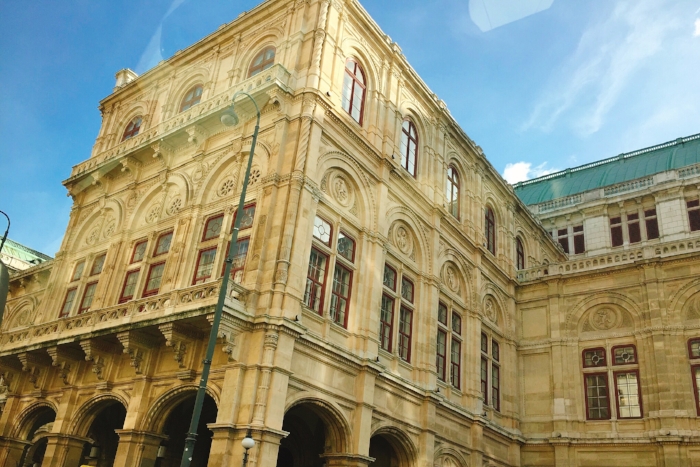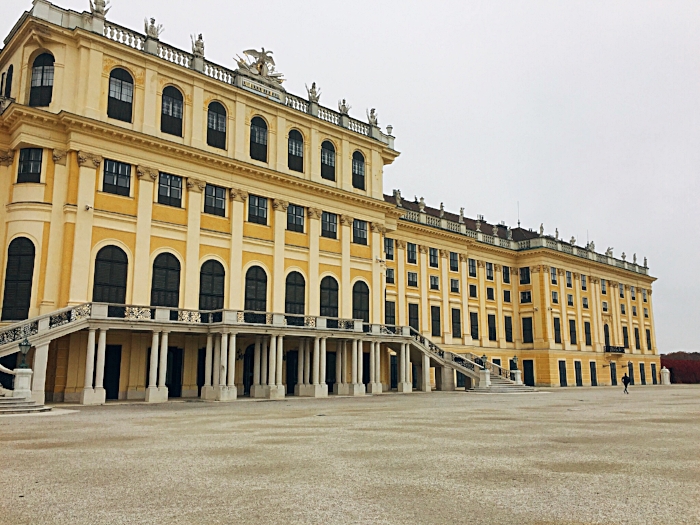Vienna Highlights: Part 2
Built in the Neo-Renaissance style, the Vienna State Opera House or the Wiener Staatsoper opened its doors with Mozart's Don Juan in the presence of Emperor Franz Joseph and Empress Elisabeth on May 25, 1869.
This second part of my blog post brings the spotlight on the areas in and around the Ringstraße, and other locations that I believe are a must-see in Vienna. In my opinion, these locations once again show the opulence of the city's glorious Imperial past.
The Ring Road (Ringstraße)
The Ringstraße was constructed 1857 by the instruction of Kaiser (Emperor) Franz Josef to demolish the existing walls and moats that fenced in Austria's nobility and opened its doors to the growing number of bourgeoisie. In it were plans to erect a boulevard of new buildings that would showcase the grandeur and illustrious Habsburg Empire. The Ringstraße is 5.3 kilometers long that provided enough space for Vienna's monumental buildings and magnificent private palaces that housed Vienna's elite built in the Ringstraße style.
Vienna State Opera (Wiener Staatsoper)
If you want top-notch entertainment in Vienna, then the Vienna State Opera is one place that should not be missed, as it one of the finest addresses in the world. With daily programs that vary from one another, this famous stage offers over 50 different operas and ballet performances that run 300 days per season.
Currently, the Vienna State Opera houses the most extensive repertoire and has been under the direction of Dominique Meyer since September 1, 2010.
Hotel Sacher is known as the only privately owned luxury hotel in the city. It is a Viennese institution situated directly opposite the State Opera. This hotel is best characterized by the unique balance of maintaining traditions set amidst contemporary elements, providing authenticity to the place. Interestingly, every room boats of rare antique collections thus making it to one of Austria's most extensive private art collections to date. Apart from being a state-of-the-art hotel, the Hotel Sacher's most famous derivative is the Sacher-Torte. You can sink your teeth into this time-honored dessert inside its equally renowned coffee shop, Café Sacher.
The Albertina Museum Vienna (Albertina)
The Albertina prides itself on having one of Europe's most important compilations of Modernist art. Its permanent display consists of artists from the Impressionism and Post-Impressionism eras such as Monet, Degas, Cézanne, Toulouse-Lautrec, and Gauguin. Other highlights also include German Expressionism and groups from Die Brücke and Der Blaue Reiter, and the art of New Objectivity, with creations by Wacker, Sedlacek, and Hofer. Austrian art also takes center stage with pieces from Kokoschka and paintings by Egger-Lienz. Not to be outdone are Russians with artistry represented in paintings from Goncharova, Malevich, and Chagall. Last but definitely not the least are are the numerous chefs-d'oeuvre productions by Picasso that range from his early Cubist images as well as works from his later period of the 1940s, to superb prints that have not yet been exhibited, and paintings from his late experimental period.
The University of Vienna (Universität Wien)
Luckily for us, the University of Vienna offers guided tours through the main building. These guided tours, which are available both in German and English, provide an overview into the interiors of the oldest university in the German‐speaking cultural region. Highlights of the tour include the Arcade Court in the shape of a Campo Santo which is located at the Main Ceremonial Chamber. When this space is available for viewing, you can find the ceilings are decorated with copies of the mural paintings by Gustav Klimt and also glimpse the Great Reading Room of the University Library.
Secession Building (Secession)
During the years 1897-1898, Architect Josef Maria Olbrich erected the Secession building in the Jugendstil style, also known as German-style Art Nouveau. It was built as a display space for artists working in the new Secession artistic movement and topped by a giant, frizzy golden ball, lovingly called Krauthappel by the Viennese. The entryway features the motto of the Secessionist movement: Der Zeit Ihre Kunst, der Kunst Ihre Freiheit (To the time, its art, to the art, its freedom). The building's design is inspired by the Beethoven Frieze from Gustav Klimt that is partially preserved in its basement.
Austrian Parliament Building (Parliament)
The Vienna Parliament building with the Pallas Athene statue in the front is one of the most important buildings in the Ringstraße. Constructed between 1874-1883, architect Theophil Hansen's plans called for a Greek-Roman style structure mimicking the cradle of democracy and designed it resembling a temple, bringing back the splendor of Ancient Greece. At the very front of the building, the goddess of wisdom Pallas Athene holds a small figure of Nike, the goddess of victory on her right hand and in her left side a spear. It is explained as such that she is surrounded by the personification of the legislation (right side) and the execution (left side) of the laws.
Vienna City Hall (Rathaus)
I believe that the City Hall built between the years 1872 and 1883, is one of the most eye-catching amongst other monumental buildings along Vienna's Ringroad. Unlike the typical Historicism-themed buildings within the Ringstraße, the City Hall was built in Gothic style, with a tower that mimic other gothic cathedrals. Its architect, Freidrich Schmidt saw the Medieval era as the growth of the cities and the emergence of an urban bourgeoisie hence it was constructed in Gothic design. Today, the City Hall is the head office of Vienna's municipal administration with more than 2000 people calling this space their place of work. Visitors are left breathless when they encounter the impressive appointments of each stateroom which frequently and aptly provide an ethereal backdrop to various events such as press conferences, concerts or balls.
Maria Theresia Monument (Maria Theresien Platz)
The Maria Theresien Platz is situated directly at the Ringstraße, embedded within the imperial scenery between two museums, namely the Museum of Natural History on one side and the Museum of Natural Art History on the other. Classified as a World Cultural Heritage memorial, this monument is dedicated to the great Habsburger, the ruler who dominated the Austro-Hungarian Empire from 1740-1780 along with her 16 children. Empress Maria Theresia is a 6m large bronze statue and greets her people with her right hand, and on her left, she holds the document roll of the -Pragmatische Sanktion- and a scepter surrounded by four horsemen that represent her generals.
National Theater (Burgtheater)
The Burgtheater is also known as "Burg", or "Haus am Ring" (House at Ring Boulevard) that lies along Vienna's first district immediately opposite the City Hall. The Burgtheater has acquired a worldwide reputation for its brilliant dramatic art and is one of the first theaters of German-speaking Europe. Over the years, the theatrical company along with its regular members continue to work in a traditional style and speech, characteristic of Burgtheater performances.
Votive Church (Votivkirche)
This Neo-Gothic church was completed as a votive to thank God for saving Kaiser Franz Joseph from an attempted assassination when Hungarian nationalist, János Libényi attacked the Emperor from behind, stabbing him in the neck with a dagger. The blow was ricochet by the Emperor's collared uniform but left him with a deep wound. The high collar uniform decked with full embroidery was customarily used by the Emperor that almost entirely encloses the neck, thus failing the assassination attempt, allowing the Emperor to live. In gratitude for His Majesty's blessed fate, his brother, Archduke Ferdinand Maximilian, began a campaign to build a new church on the site of the attack. Funds for construction were solicited from all over the Empire, and the church was inaugurated in 1879 on the silver anniversary of Emperor Franz Joseph and his wife, Empress Elisabeth.
Schönbrunn Palace (Schloß Schönbrunn)
This building does not lie along the Ringstraße, but I just cannot write about Vienna and exclude this palace -- my favorite palace in the world -- the Schönbrunn. From the 18th century to 1918, Schönbrunn was the residence of the Habsburg emperors. Together with its lush gardens, it is the site of the first zoo during 1752. The Schönbrunn is a masterpiece work of Baroque architecture and is a perfect example of Gesamtkunstwerk. This summer palace for the Habsburgs' former inhabitants include Maria Theresia, Emperor Franz Joseph, and Sisi.
The color painted throughout the palace is called the Schönbrunn yellow.
Vienna's Naschmarkt (Naschmarkt)
Another one of my favorite places to visit in Vienna is the Naschmarkt. It is Vienna's best-known market that has roughly 120 market stands and restaurants for you to choose from. These days, the Naschmarkt has developed into a meeting place for the young and old as well as a place for culinary delights. I remember going to the Naschmarkt as a child with my mom as she strode along the vendors of the flea market on the weekends. Then and now, this place always bring me joy.
If you're looking for a place that's right smack near the Naschmarkt, then Hotel Beethoven is the place to be. Walking approximately two blocks from the Naschmarkt is a hotel that mixes the old, and the new. Hotel Beethoven showcases the best in Viennese music and art on every floor. What I like most are the weekly concerts that play Viennese classics such as Mozart, Haydn, and of course, Beethoven held at the mezzanine.
Belvedere Palace (Belvedere)
The Belvedere was once the summer palace of Prince Eugene of Savoy who was an accomplished general and avid art connoisseur. Located in the third district, the Belvedere is one of the most important baroque buildings in Austria housing the largest collection of Gustav Klimt's masterpieces such as "The Kiss" and "Judith." The Belvedere palace consists of two separate buildings namely the Upper and Lower Belvedere, which is connected by a stunning Baroque-style garden. A leisurely stroll around the garden will surely invigorate the mind and soul.
Vienna Prater (Wurstelprater)
Prater isn't just any other amusement park, for me, this place holds fond memories of my childhood with the giant Ferris wheel as Vienna's one of the most enduring symbols towering above the city and running around its grounds like a wild child. The Vienna Prater is open from March to October. However, the world-famous giant Ferris wheel and a few other attractions are open all year round. I would not only ride the rides as a little girl, but also stuff myself full of carnival eats such as the Lángos, a Hungarian dish to be eaten on the go and the Schweinstelze (pork knuckles). Yummy!!! If you have kids or are a kid yourself (who isn't?) a visit to the Prater is definitely a worthwhile experience.
Vienna is indeed such a beautiful city, and I know that even with two blog posts, I may never fully articulate its majestic glory. This place is truly magical and is best experienced up close and personal ... and when you do, I'm sure it's going to be one you'll remember for a lifetime!
Is there anything you'd like to add to this list? Feel free to comment below.





